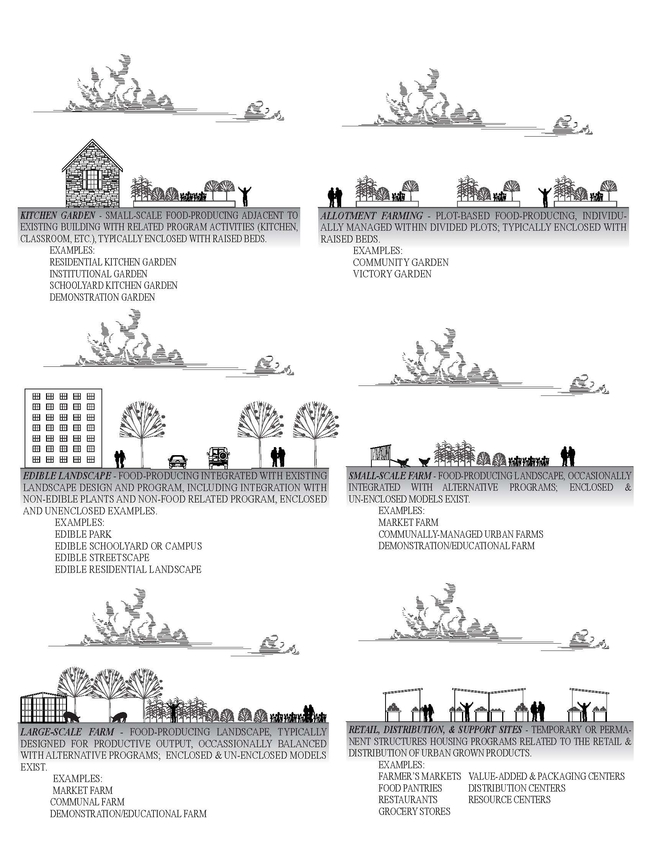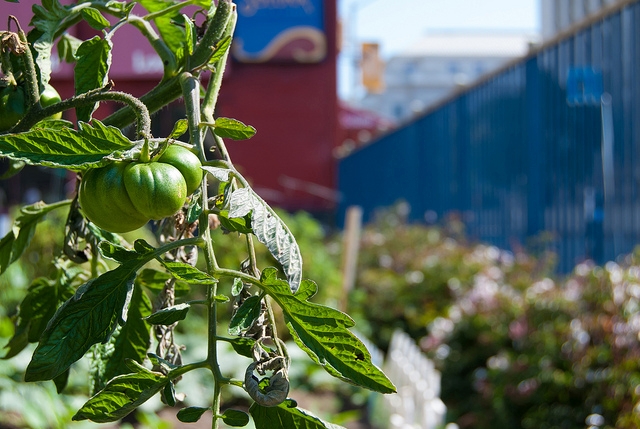- Author: claire napawan

The spatial needs of successful public space include a strong neighborhood connection, an accessible perimeter, and a site design and layout that promotes many and diverse users. Communally-managed urban farms benefit from similar spatial considerations: strong connections to neighborhood context insure a strong community commitment to the demanding maintenance needs of a production landscape, strong physical and visual accessibility promotes diverse users of the site, and flexible layouts and designs encourage diverse programs within the site. The consideration of the communally-managed urban farm site as a whole, and not parceled into individualized plots, allows for the use of smaller and more constrained urban sites and a greater shared commitment to the entirety of the site. This can help lessen one of the consequences of a shared public and production landscape: theft. While perimeter fencing might be a requirement of other forms of urban agriculture, a communally-managed urban farm is more resilient to the impacts of leaving a site open and accessible to the public. In addition, the accessibility of the site can lead to a higher volume of volunteer participation, consistent maintenance and good overall site appearance, and a strong sense of ownership by surrounding community (including those not interested in urban farming). Thus, although often perceived as an incompatibility, this investigation reveals that an open site perimeter, as well as the other spatial considerations of a successful public space, are consistent to the design of a successful communally-managed urban farm.
Many urban farmers and gardeners are not aware that in order to legally sell their produce, they need to be an “approved source.” According to the California Retail Food Code (CalCode), "an approved source operates using current public health principals and practices, and generally recognized industry standards that protect public health." Luckily, there are many ways for producers to become an approved source—including some new and innovative programs in the San Francisco North Bay!
The core concept is simple: food sold to the public must be safe to eat. In order to ensure this, CalCode requires all retail food facilities to obtain food from an “approved source,” ensuring traceability back to the original producer so the origin of any contaminated product or unsafe food can be located. The most common ways to become an approved source are:
- Certified Producer's Certificate (CPC) for selling at farmers markets from the County Agricultural Commissioner's Office.
- Operator Identification Number for pesticide use from the County Agricultural Commissioner's Office.
- Organic Producer certified by an official third party organic certifier (if the expected organic gross sales exceed $5,000), registered with the California Department of Food and Agriculture Organic Program, and submitted to the County Agricultural Commissioner's Office.
- Community Supported Agriculture (CSA) registered with the California Department of Food and Agriculture.
However, many urban farmers and gardeners fall through the bureaucratic cracks. Disconnected from the farming know-how about how to become an approved source or too small to necessitate the traditional industry documentation, they unknowingly put themselves and the people who eat their produce at risk. Fortunately, three San Francisco North Bay Counties—Mendocino, Napa, and Sonoma—have developed an innovative solution by creating their own Approved Source programs.
Designed with urban farmers and culinary, home, school, and community gardeners in mind, these Approved Source programs enable growers to legally sell or donate their produce to retail food and food preparation facilities such as restaurants, soup kitchens, food banks, and school meal programs. These voluntary, practical, and no-cost programs help growers meet the intention of CalCode's Approved Source through transparency and best management practices for food safety. Growers simply register online with their business name and contact information which provides the necessary traceability, and they self-certify that they follow common-sense best management practices that reduce food safety risks from contamination and the transmission of pathogens through water, soil amendments, worker hygiene, and post-harvest handling. Interested in learning more? Read on to hear how each of these programs developed.
Napa County's Best Management Practices Agreement for a Garden to become an “Approved Source” was developed in 2012 to address the growing popularity of culinary gardens popping up at Napa Valley restaurants and wineries. The NapaLocal Food Advisory Council worked on the topic, forming a subcommittee comprised of County staff from the Agricultural Commissioner's Office, Environmental Health, and the Planning Department, as well as community members. They hosted an approved source roundtable to gauge community concerns and interest. Then they reflected on how the Agriculture Commissioner's office might help culinary gardens attain the approved source designation through the Office's existing services, and they created their own working definition of what it meant to be an “approved source” since CalCode allows for Environmental Health to use their own criteria for determining the designation. From these early conversations, it became clear that there needed to be a different process for growers not served by the typical approved source designations that were already in place.
As a result, the Agriculture Commissioner's Office and the Napa County Environmental Health Department developed a self-certification process for growers based on a set of mutually agreed-upon Best Management Practices. Then the County's Information Technology Services created an online questionnaire that automatically populates the information into a publicly available online database. According to County staff, the development of the program took a cooperative effort between the Agricultural Commissioner's Office and Environmental Health, and by working together, they were able to develop something that meets the needs of local growers, protects public health, and is easy for the County to manage. Currently, the program has 26 producers registered, including culinary gardens at restaurants and wineries as well as educational gardens at schools, colleges, and nonprofit organizations.
Sonoma County Approved Produce Gardener Certificate was based on the success of Napa's program and developed by the Sonoma County Department of Health Services, the Sonoma County Agricultural Commissioner's Office, and UC Cooperative Extension, with assistance from the County's legal counsel and Information Services. The team met a half dozen times over a number of months to develop the program, test the website, and deliver two workshops to interested producers. Their primary challenges were how to develop and launch the new program without a budget, how to make the website simple to use and easy to understand, and how to make sure users would actually read the Best Management Practices and agree to abide by them. Based on the successful launch of the program, there are now currently 76 registered growers, with a total of 190 registered since the program was first rolled out in April 2013.
Mendocino County Approved Source(MCAS) was launched just this year and developed cooperatively with Mendocino County Environmental Health, the Agriculture Commissioner, Information Services, and the Mendocino County Food Policy Council. The goals behind the program were to protect food safety while opening new markets for local, small-scale produce growers in order to support local economic development. Interestingly, although their program is designed primarily for Mendocino growers, MCAS welcomes growers from neighboring counties to register, in hopes of fostering greater reciprocity between the other North Bay counties and enabling growers to expand to markets beyond county boundaries. In less than a year, the program already has 19 producers certified, including a couple from neighboring Lake County.
For more information:
- Napa County - Napa County Best Management Practices Agreement for a Garden to Become an “Approved Source”
- Sonoma County - Sonoma County Approved Produce Gardener Certificate
- Mendocino County - Mendocino County Approved Source (MCAS) Program
- And for another similar program, see San Diego County's Conditional Approval of a Culinary Garden Food Source for a Regulated Food Facility
On August 7, San Francisco officially became the first city in California to establish an urban agriculture incentive zone. Following passage of a law introduced by Supervisor David Chiu and unanimously supported by the Board of Supervisors and Mayor, owners of vacant property within San Francisco will now be able to apply for a property tax reduction in exchange for committing their land to urban agricultural use for at least five years. San Francisco's new law is the first local implementation of Assembly Bill 551 since that state bill went into effect at the start of this year.
The San Francisco legislation has a number of main features:
The entirety of San Francisco would be considered an urban agriculture incentive zone, which means that that any parcel that met the eligibility requirements set out in state and local law could receive a reduced property tax assessment.
- The Planning Department would be responsible for certifying a parcel's eligibility based on its size, existing structures, and access to water.
- If a parcel is eligible, the property owner would submit an application to the Agricultural Commissioner explaining the plans for agricultural use of the site. The proposal goes above and beyond the state's minimum requirements by requiring the property owner to demonstrate through their plans that the farming or gardening on the property would have some interface with the public through either distribution or sales of food; educational activities such as classes and workshops; or that that site is being used as a community garden with members other than the property owners' family.
- The Agricultural Commissioner would be responsible for both reviewing the plans in the application as well as conducting annual site inspections after a contract is signed to ensure that the site is used solely for agricultural purposes.
- The Assessor-Recorder would be responsible for calculating the change in property taxes and providing that information to the Agricultural Commissioner and property owner.
- If an application is approved, the property owner would sign a contract with specific terms, to be enforced by the Agricultural Commissioner.
- The legislation explicitly allows the agencies involved to establish fees to process the initial application and defray the costs of annual inspections.
The legislation also has a number of safeguards to prevent abuse:
- Any proposed contract that would reduce property tax revenue to the city by $25,000 or more each year; result in five contiguous acres under contract; or would increase total revenue loss to the city above $250,000 annually for all properties under contract would automatically be sent to the Board of Supervisors for review.
- If a contract is cancelled by either the property owner or by the city because the property owner is found to be in breach of contract prior to the expiration of its five year term, the landowner would be required to pay the city all back taxes, with interest (as determined by the Assessor-Recorder).
- To provide an additional check and balance for the program, the Board of Supervisors has a ten-day window after receiving the Agricultural Commissioner's list of recommended contracts to request a hearing to review any contract. If the Board does not request a hearing, a recommended contract can be approved administratively.
The final details of the application and contract itself are now being worked out by city agencies so that property owners can apply by the October 1, 2014 deadline. While San Francisco has a limited amount of vacant land, local advocates are hopeful that the law will support a number of projects in the city while also inspiring other cities and counties across the state to establish urban agriculture incentive zones. It's one tool that has great potential for supporting greater land access and land tenure for urban farmers and gardeners so that more people in the state can benefit from urban agriculture.
Learn more:
- Read San Francisco's Urban Agriculture Incentive Zone ordinance
- Read UC ANR's Guide to Implementing the Urban Agriculture Incentive Zones Act (AB 551)
- Anyone in San Francisco interested in applying for an urban agriculture incentive zone contract should contact the city's Urban Agriculture Program Coordinator
- Watch a KPIX news piece about the ordinance
Eli Zigas is the Food Systems and Urban Agriculture Program Manager at SPUR (San Francisco Planning and Urban Research).





